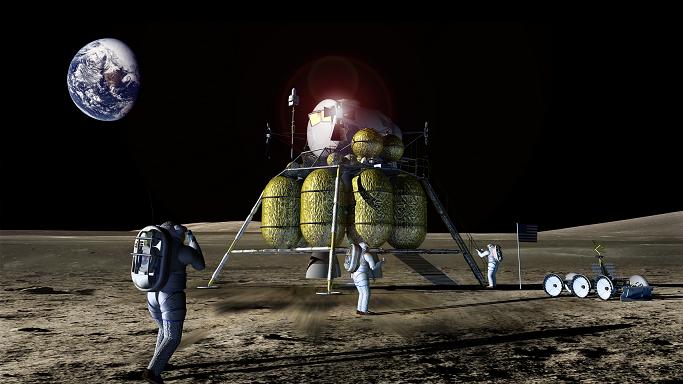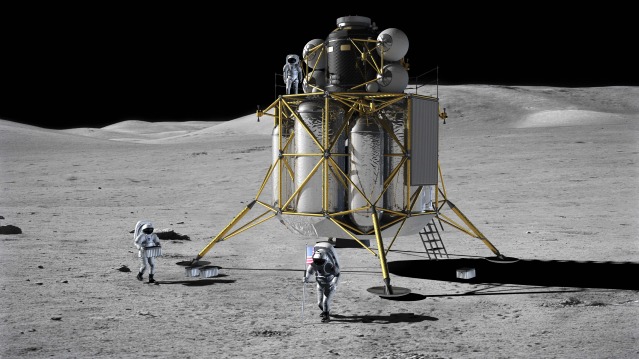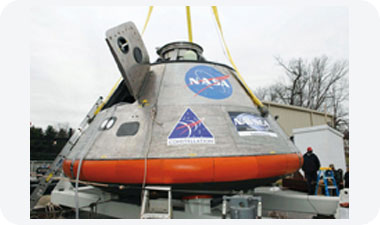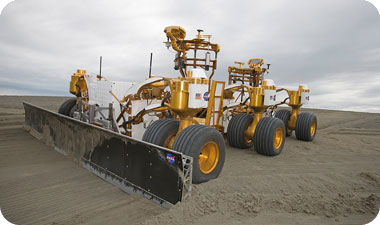After an achievement like landing on the moon, what other challenges are facing man? With launchers and spacecraft bearing the names Ares, Saturn and Orion, there seems to be a lot to talk about
Amber dew Galileo Magazine

On July 1969, 11, an ancient dream of man came true when two representatives of humanity, Neil Armstrong and Buzz Aldrin, landed on the dusty soil of the "Sea of Tranquility" on the moon. Apollo XNUMX, the first manned spacecraft to land on the moon (and one of six manned landings in total as part of the Apollo mission), was a historical landmark in space exploration, advanced technology and the space race between the United States and the Soviet Union.
The bold declaration of US President Kennedy from 1961 ("I believe that this nation must undertake, before the end of the decade, to land a man on the moon and return him to the earth in peace") has been fulfilled. The USA celebrated its victory over the USSR, the moon landing was the most watched event in the history of television up to that time, and the general public wondered where else man would go, and what the future would look like for him with modern technology.
In the corridors of NASA headquarters in Washington, D.C., as well as in its various facilities scattered throughout the United States, a note of apprehension also crept into the feeling of supreme achievement. Now, precisely at the height of the success of the American space agency, which was founded a total of eleven years before the placing of the US flag on the moon, it was feared that Congress would land the sword of cuts in the research and development budgets, and that the expenses of the war in Vietnam would eat into the budgets of the follow-up programs to Apollo. It seems that even the most fearful among NASA engineers and its managers did not imagine that the adventure of the Apollo operation would end only three years after the Apollo 11 mission, and that it would be about fifty years before man would return and set foot on the moon, in 2019 exactly.
Where do we go from here?
Operation Apollo was first and foremost a political operation, which cannot be understood without an in-depth reference to the Cold War between the USA and the USSR. In the absence of the will of the two superpowers to fight each other directly on the battlefield (which would almost certainly have turned into a war of nuclear annihilation), violent conflicts were conducted for years around the globe, in which countries supported by one side or the other fought.
The two powers found themselves an arena of technological conflict - space, and in the race that characterized the first decade of space exploration using satellites and manned spacecraft, Kennedy set a clear end goal: a manned landing on the moon. From the moment the finish line was set, it was a political goal of the highest order to win in the space arena, and the US succeeded in doing so after huge investments and an enormous effort, the administrative aspect of which did not in the least fall short of the technological achievements. With the achievement of the goal, in July 1969, the question arose in all its acuteness: where do we go from here?
The answer, disappointingly, was "nowhere". Three of the Apollo missions intended to land on the moon were canceled, and plans for a manned mission to Mars were abandoned. After a difficult struggle, NASA managed to implement a small part of what was called "Apollo applications" - within this framework, the first US space station, Skylab, was built and launched, to which three teams of astronauts were sent in 1974-1973. He also started planning the space shuttle, known to readers also from its missions today.
The lack of leaders with a courageous vision, focus, lack of a sense of mission and vocation and a lack of considerable budgets have been characteristics of the American space program for decades. Here we will illuminate some aspects of the new US space program for the exploration of the moon, and we will highlight the cases where the legacy of Apollo pulses in a new space program, both in the technological aspects of its missions and in its political-political characteristics.
"]![Right: J-2-X engine: a re-production of the second and third stage engine of the Saturn 5 rocket, and for comparison - an original J-2 engine from the Apollo era [courtesy of nasa photo] Right: J-2-X engine: a re-production of the second and third stage engine of the Saturn 5 rocket, and for comparison - an original J-2 engine from the Apollo era [courtesy of nasa photo]](https://www.hayadan.org.il/images/content2/space/j2x.jpg)
Orion, Constellation and Ores
Constellation program
It is the name of the fifth manned space program of the USA after the operations Mercury, Gemini, Apollo and the space shuttle. The main goal of the program is to land on the moon and establish a permanent base on it, and later to carry out manned missions from the moon to the planet Mars. The program is being carried out simultaneously with the preparations for the end of the operation of the US space shuttles in 2010.
The program includes the design of a new spacecraft and two launch missiles called Ares 1 and Ares 5 (Ares). The spacecraft, named "Orion", is very similar in design to the Apollo spacecraft and it will be possible to launch four people to the moon and six to the space station orbiting the Earth.
The hardware on the spacecraft was designed for a large number of missions, including supplies to the International Space Station, landing on the moon, a manned mission to asteroids and a manned mission to Mars.
Much of the hardware for the launch vehicles is based on systems originally designed for the American space shuttles. A very important feature of the Ares 1 missile is the possibility for the crew to escape in an emergency, an ability that does not actually exist in space shuttle missions (as evidenced by the devastating results of the space shuttle disasters "Challenger" and "Columbia"). When necessary, the Orion spacecraft will be detached from the launcher that carries it, and will be moved to an altitude of several kilometers using rocket engines installed in the nose of the launcher in a configuration known as an "escape tower". Experiments in this system are already being done these days.
Difference in mission architecture
The Saturn 5 rocket was the most powerful space launcher ever developed in the US. Despite being such, the task of launching an Apollo spacecraft to the moon was a major task, if we remember to what speed the spacecraft had to be accelerated - 11.2 kilometers per second! The huge rocket (111 meters high) needed enormous amounts of fuel and large engines to launch the Apollo spacecraft and its landing vehicle to the moon. However, a strategy was adopted according to which one Saturn 5 launcher was sufficient to carry out the Apollo mission.
In the Constellation program, on the other hand, two separate space launchers are needed to carry out a mission that previously required a single launcher - the large launcher of the Ares 5 type (the number attached to it is not accidental, and is intended to create an affinity with the name "Saturn 5") will carry the lunar landing vehicle, the The equipment required for a prolonged stay on the surface of the moon, as well as a large acceleration stage that includes rocket engines, fuel and oxidizer. The smaller Ares 1 launcher will carry the Orion spacecraft and its crew into low Earth orbit. In orbit around the Earth, the Orion spacecraft will maneuver and connect to the lunar acceleration stage launched with the Ares 5.
Much criticism has been heard among experts regarding this mission configuration for being more complex and expensive than a single large launcher. However, even though other alternatives were put forward, NASA stuck to this plan which calls for the construction of two large, disposable rockets for each lunar mission.
Orion - Apollo Plus?
After a tender between the aerospace giants Boeing and Lockheed Martin, NASA decided in August 2006 to entrust Lockheed Martin with leading the design and construction of the Orion spacecraft, a spacecraft for a variety of missions including transporting four crew members to the moon. The design of the spacecraft is very similar to the Apollo spacecraft, with one key difference - the spacecraft is equipped with photovoltaic cells (solar cells) to produce electricity.
The spaceship has two parts: the front part, in the shape of a cone, serves as the command cabin and the crew's residence, and the cylindrical rear part includes a rocket engine, systems for generating electricity, oxygen, water and other systems designed to support the existence of the crew members while in space. The only part that should return to Earth at the end of a space mission to the Moon is the command cabin of the Orion spacecraft. NASA people came to the conclusion that a conical shape is the safest for entering the Earth's atmosphere.
Orion will be larger than the Apollo spaceships: its base diameter will be five meters (compared to Apollo's 3.9 meters) and its volume will be 2.5 times greater than the volume of the Apollo spaceship (the volume of the Apollo spaceship was only 6.17 cubic meters!) Its mass will reach 25 tons. In contrast, Orion is much smaller than the Space Shuttle. The maiden flight of the spacecraft, to the International Space Station, is expected to take place by 2014 and its first flight to the moon is expected to take place by 2020. The spacecraft will be carried by one of two rockets: the Ares 1 (Ares I) rocket will be used to carry people and the Ares 5 Ares V rocket will be used to carry cargo ) ), a taller and larger missile.

the heat shield
The heat shield is a part of the spacecraft, designed to absorb the enormous heat that develops when a spacecraft returns from space to the Earth's atmosphere, a transition that can cause temperatures of about 1700 degrees Celsius. Without a heat shield any spacecraft will burn up and be destroyed upon entering the atmosphere.
At the beginning of the space age, the USA installed in its manned spaceships disposable heat shields, which gradually decayed upon entering the atmosphere, but were designed accordingly and were thick enough to protect the spaceship until landing. Rather, heat shields were called "ablative", meaning the material they were made of burned and evaporated. They were very expensive and difficult to produce.
With the development of the space shuttle, NASA decided to convert the proven technology of these heat shields into an innovative technology of special ceramic insulation tiles, which can be reused, albeit at the high cost of complex and expensive maintenance.
The designers of the Orion spacecraft decided to return to the days of Apollo and the old technologies of expendable heat shields. The knowledge to produce them has not been preserved in the USA, and today accelerated work is being carried out to rebuild production facilities for heat shields of the type used by the USA forty years ago and more.

J-2-X engine
When NASA's design teams began to characterize the future Ares 1 and 5 launchers, a puzzling fact became clear - the US does not have a rocket engine whose technical data allows it to be included as an engine for the upper stage of the future launchers required to carry out the moon program. The various companies involved in the development of rocket engines offered all kinds of proposals, all of which were rejected after being examined, except for one that initially seemed fanciful: the J-2 engine developed in the mid-sixties of the last century, and which was the engine installed in the second and third stages of the previous Saturn rocket, should be "revived" 5.
After checking the inventory and finds of engines of this type, which have not been used for decades, and are in space museums or NASA warehouses, it was decided to produce prototypes of the old engine, and it was assigned the nickname J-2-X. Existing engines were taken out of storage and museums, scanned with state-of-the-art imaging technologies and engineering plans were produced from them. First experiments with the engine of the past - which today of course also includes various modern technologies - are already being conducted in the USA. It turns out that "old engines do not die", but wait for their turn. It is impressive to see how an engine that was designed almost before the anniversary, will serve for decades in demanding space missions.
Altair, mobile homes and innovative vehicles
The most fundamental difference between the Apollo programs and the Orion and Constellation programs lies perhaps in the lunar components of the project. While the Apollo missions were intended for only a short stay on the moon (the record stay was three days on Earth, and was set by the Apollo 17 spacecraft, the last to land on the moon), future NASA missions will last weeks and eventually even months. For this purpose, a variety of lunar vehicles are currently being developed, including cars, bulldozers and mobile residential buildings; The technology of inflatable components is also tested. (and see "inflate in space")
The Apollo astronauts who recently visited NASA and closely examined the prototypes of the advanced landing gear commented that they could only dream of such convenience. Among other things, the future astronauts who will explore the moon in a decade or more will be able to enjoy improved living conditions, a lot of space and especially the ability to work without space suits inside the various residences and vehicles.

A new space race?
The question can be asked - and rightly so - why is the US returning to the moon? The answer to this question is not simple at all. The US is not currently in a space race with other countries, at least not publicly. Such a race is underway in Asia. It seems that the main reason for initiating the new plan to return to the moon is the American desire to get out of years of technological and conceptual stagnation - in terms of a "flight to nowhere". The USA, it and its partners with it, did indeed build the International Space Station and conducted many flights of the space shuttle; However, since the days of President Kennedy and the Apollo missions, the scientists, engineers and industries in the USA have not been presented with a real challenge in space exploration, which would sweep the public after it.
At this stage it is still too early to know whether the first significant US space project in decades will lead to identification and cohesion, to igniting the imagination and technological breakthroughs like the heyday of NASA in the Apollo years, but these elements today seem to be just as important as the technical and engineering capabilities in building space missions. If a time-bound target is set for a manned landing on Mars (and thick hints of this have already been heard from the direction of China), then we can witness in the third decade of the twenty-first century a real space race, in which the American ability will be tested against a combination of countries that aspire to position themselves as leaders in the field of space.
The technological legacy of the Apollo operation and the historic landing from forty years ago still has a great influence on our lives today, even if a significant part of the readers do not give their opinion about it - miniaturization in the field of electronics and computers, technologies of aircraft and vehicle safety, project management methods and computerized inventory organization in warehouses Logistics, medical monitoring technologies, hundreds of new materials and food production technologies - all are part of the technological legacy of the Apollo operation.
What will be left in another jubilee from the Orion spacecraft and the future space operations? It is hard to imagine, although it is to be hoped that together with the technological and economic improvements that large space operations can yield, the human race will learn how many its capabilities are in unity, when it comes to order our solar system and think about concentrating the effort on the challenges that nature poses to us, and not human nature.
The author is the head of the Center for Space Research, the Fisher Institute for Strategic Air and Space Research, and the chairman of the Israel Space Association. The article was published in the July 2009 issue of the Galileo journal.
More on the subject on the science website

7 תגובות
There is a technology called electro gravitics, which has existed since the XNUMXs and is hidden by the American military. But today there are already people who deal with it privately - search YouTube for the word lifter. You should know, at the same time, that the American military has many secret technologies, including anti gravity. Look for Stan Deyo's lecture on eBay.
Dvir:
The answer is that it is not possible to give birth to a normal baby (in mice) under weightless conditions.
The technology is already ready, you just need "a little" money and courage. Already in the 60s, nuclear engines were developed in the USA [Nerva project] to send people to Mars. Even more advanced engines [timberwind project] but this project was also closed a little before the first prototype was expected to be built, all this was done by the stupid Clanton and his anti-scientific leadership friends.
Until there is a breakthrough in the field of sending cargo and people into space, we will not leave the earth...
The hack could be by way of an elevator into space or some kind of new mission so that the cost would be really minimal and low.
Then the space age will really begin...
spacex is commissioned by nasa and their rocket failed in most of their tests also the dragon is expected to be a spacecraft supplying people and cargo from the space station from 2012 to 2020? And not beyond that until Orion is ready, which will happen only in 2014.
Is it possible to get pregnant and give birth to a normal baby, in an environment with one-sixth the gravity of Earth?
The future is in private and not public money
The future is in private spaceships, for example the Dragon
http://www.spacex.com/dragon.php
This year - first flight and circumnavigation of the earth
2010 - Physical connection to the International Space Station